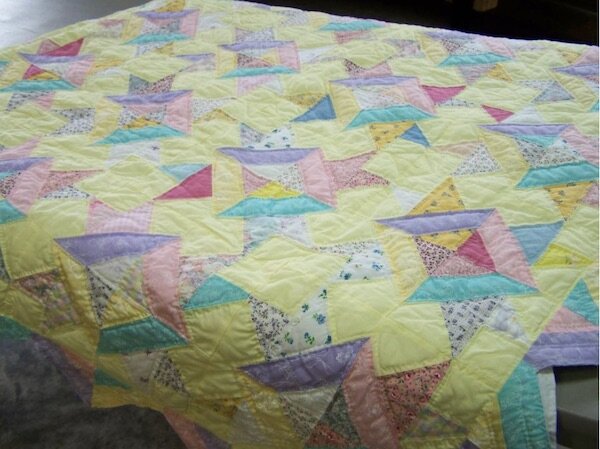Getting Closer to an Actual Quilt
I’ve been using page layout and design software since the days of Pagemaker. We used Pagemaker in college to lay out the newspaper and literary magazine (the husband was the editor of both) and Twists and Turns actually started out in Pagemaker and transitioned to InDesign. Having been out of the design business for about 10 years while I was working as a medical transcriptionist, I was dismayed to discover that Adobe’s business model has changed. You no longer are able to purchase the Adobe suite of apps on disc and keep them for years. Now you have to “rent” them from Adobe.
[I have lots of thoughts about this. I am sure you can guess what they are.]
When I decided to close my Ravelry account and move everything back to my website, I went ahead and “subscribed” to InDesign so I could update my pattern files. I pay $20 a month for that privilege. I didn’t need Illustrator or Photoshop because all of those files were embedded in my patterns. Unfortunately, now that I have decided to publish a quilt pattern, I need Illustrator.
[Yes, I know there are open source packages out there, but they have never worked as well for me as the gold standard software programs. I am annoyed enough that EQ8 doesn’t behave like Illustrator.]
The husband has my old Mac tower. It still has the last Adobe suite I paid for in 2008 on it. As it is going to be in the mid-90s here this week, I thought that working in the cool basement in the afternoons, drawing all the schematics I needed in the old version of Illustrator, would be a good plan, so I headed down there yesterday after lunch.
Illustrator worked, sort of. Some features don’t show up, other features work intermittently, and that computer—for all that it served me so well for over a decade—just isn’t as zippy as my current one. I resigned myself to going back to my computer and “renting” Illustrator in addition to InDesign.
The universe must have heard me grumbling, because when I came back upstairs and checked my e-mail, there was a special offer from Adobe. If I subscribed now, I could get all the apps for $10 a month more than I am currently paying just for InDesign. That was too attractive an offer to pass up.
I’m glad I did it. Illustrator works beautifully on my office computer and I was able to draw all of my schematics in just an hour or so. I’ll have Photoshop for when I need it, and Acrobat always comes in handy.
I enjoy writing patterns. I like the writing, I like the math, I like doing layout. Pattern production is almost as much fun as making the quilts.
***********************************************************
I finally came to a decision about the Noon and Night quilt. Although I love the bright Kona scrappy versions on the black background, my gut feeling was that I needed to make the prototype with prints. I can make a solid-color Kona version later.
I can tell that that was the right decision, because I stopped feeling so ambivalent once I committed to that plan. You’ll have to wait to see what I chose. I was helped along in my decision-making by these two quilts. The first is “Aunt Hazel’s Quilt,” from the patchpieces blog:
The second is from the Bellwether Dry Goods website.
I cannot find the source for this photo—the Pinterest link leads to a listing of quilts on the website without photos—but I was able to grab the photo from Pinterest.
And there was this photo, also on Pinterest, with no source:
Of note, the first quilt is entirely scrappy and the star points are mirrored. The second quilt is “controlled scrappy,” with what appears to be 2-3 fabrics per block. Some of the blocks have mirrored star points but some of them rotate. (?!?) The individual block in the last photo is comprised of just two fabrics. Those star points mirror, but are positive/negatives of each other.
This is such a capricious block. Every time I think I have it figured out, another variation pops up. I ordered some source material from eBay that I hope will help me determine how this block was presented originally. That is supposed to arrive soon.
I’ve had an epiphany about quilt blocks and quilt design through this process. I used to think that there was a finite number of pieced quilt block designs out there and that there was nothing new to discover or create. Nope. Church music is a close analogy. As a church pianist, I get very frustrated trying to find fresh pieces to play. Every arranger—and I mean EVERY ARRANGER—does arrangements of about 20 of the most popular hymns. You can’t swing a cat without hitting an arrangement of “Amazing Grace,” but finding an arrangement of some lesser-known hymn is next to impossible. (Some of that is due to copyright restrictions, but not all of it.) Quilt design is similar. Want a log cabin pattern? There are thousands. King’s Crown? Good luck with that one.
I’d rather muck around in the dusty old attic of forgotten and challenging quilt blocks than try to put a new spin on something that’s been done to death. Wish me luck.



